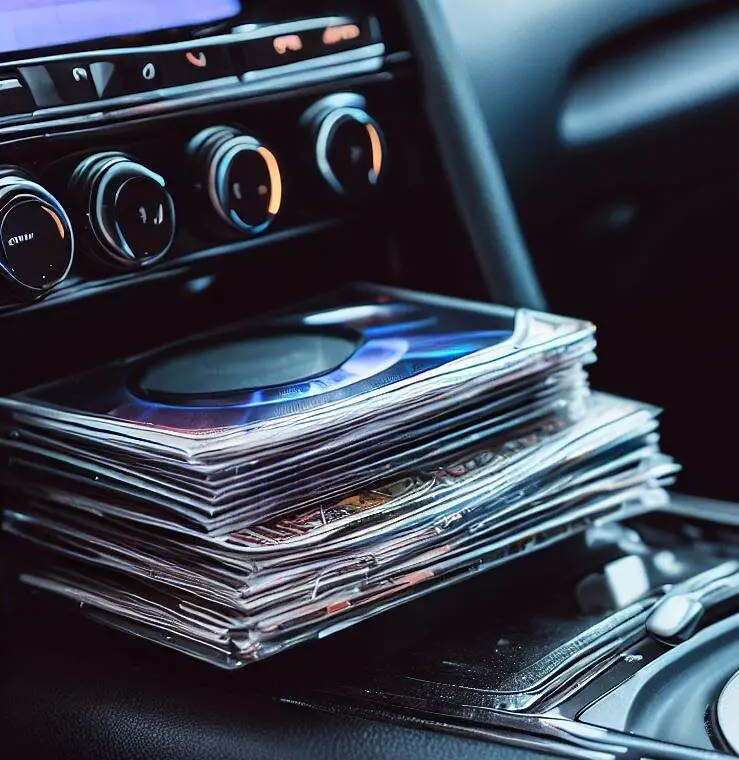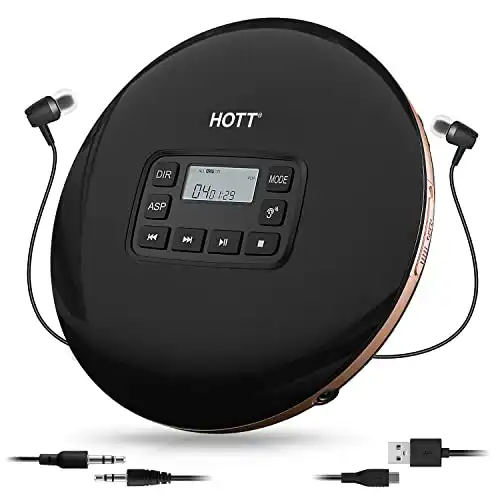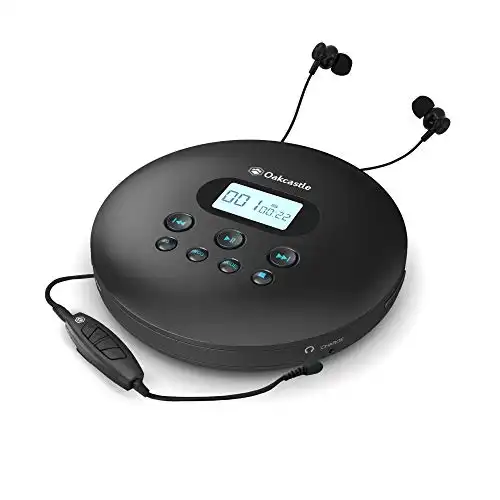As technology progresses, it sometimes renders useful technologies obsolete before we are ready to say goodbye.
There are many examples of this in the audio/visual world. From DVD players making our shelves full of VHS tapes useless, to new laptops without disc drives, to bluetooth replacing the humble 3.5 mm aux jack.
Here, we are going to discuss another common example — trying to play a CD in a newer car without a CD player.
Something about blasting your favorite CDs while driving feels like a version of pure Americana that many of us aren’t ready to get rid of. Here, we will discuss some workarounds so that you never need to.
Quick Answer: How to Play CDs in a Newer Car With No CD Player
This article provides comprehensive solutions for those who want to play CDs in modern cars without a CD player.
While portable CD players and aftermarket installations are options, we recommend digitizing your CDs into a modern format for ease of use, greater accessibility, and environmental considerations. Before proceeding, consider your priorities: convenience, cost, quality, and your readiness to transition to digital formats.
Background — What Replaces the CD Player in Newer Cars?
Obviously, nobody is buying a 2023 model car and expecting to drive it in silence. There are still many ways of listening to audio in a new car without a CD player, including apps like Android Auto and Apple CarPlay, Bluetooth connections, Sirius XM and satellite radio, and of course the humble FM & AM radio.
But sadly, the vast majority of cars that are being manufactured nowadays are being made without a CD player.
So, let’s start our discussion of ways to play your CDs in a newer car without a CD player.
There is a method that will work for everyone, it just depends on your priorities. Do you want the quickest way, the cheapest way, or the highest-quality way?
*Please note that our list is not in order of best to worst. In fact, we recommend option #3 rather than #1 or #2. But, since you are looking for ways to play a CD in a car without a CD player, we will explain the ways to do so, rather than telling you to take the recommended route of converting your audio files to MP3.
How to Play CDs in a Car with no CD Player — Top Methods Explained
(1) Portable CD Player
For anyone that truly wants to play CDs in a car without a CD player, this is the best way of doing so. Any other method will require either a conversion of your CDs to a modern digital format, or else a modification of your car receiver or stereo.
Having said that, this isn’t the route I would choose. There are a few downsides:
- Many reputable electronics companies have abandoned the manufacturing of these products. Sure, you can still find a Sony Walkman for a few hundred dollars, but is this really the way you want to be spending your money in 2022? Many of the top selling portable CD players are made by GPX, HOTT, MONODEAL, and other companies that don’t exactly compete head-to-head with Bose or Klipsch.
- Many portable CD players still cost upwards of $50.
- It still requires you to find room for a CD player in your dash, console, or passenger seat.
- An external power source will be needed to use your CD player. Sure, this will probably be as simple as finding a couple of AA batteries. But playing music in the car shouldn’t require you to think about powering your devices. With a built-in CD player, this would never be a concern. And although streaming music also requires a power source, most of us are accustomed to having a charged cell phone with us in the car, anyway.
- Even with a portable CD player, you still need additional accessories and connections in order to actually play audio through your car’s speakers.
If you gave your Sony Discman to Goodwill a decade ago, or if your portable CD player is buried at the bottom of a box in your basement, there is another clever solution that you may not have considered. If you have a laptop with a CD drive, this will work as a portable CD player. It sure beats spending $50+ for no reason.
Before you purchase a portable CD player, be sure to consider what method you will use in order to connect to your car’s audio system. There are multiple ways to do so.
3.5 mm auxiliary jack
This is the tried-and-true, reliable way of connecting external devices to car audio systems. Although aux inputs have fallen out of favor in many modern electronics, there is no denying that they make connections simple and painless.
If your car has an aux jack, just find a portable CD player that has an aux jack. The HOTT CD player discussed above comes with an aux jack and an included aux cable. From here, the steps are simple:
- Turn on your CD player and insert your CD of choice
- Plug one end of the aux cable into your portable CD player, and the other end into your car’s aux port
- Select the “AUX” input on your car’s stereo
- Press “PLAY” on your CD player and ensure that your volume is turned up
Bluetooth
Bluetooth connections can be either a blessing or a curse.
When bluetooth works the way it’s supposed to, it is a wireless connection that is easy to use and eliminates the need for cords and cables. When bluetooth doesn’t work properly, it can be extremely frustrating. In those instances, you will long for the days of the 3.5 mm aux cord that could connect an audio source to your speakers.
If your car doesn’t have an aux port, or if you just prefer to go cord-free, find a bluetooth-enabled portable CD player. The Oakcastle CD100 is a solid choice, since it also has a built-in USB-rechargeable battery and includes an aux cable as backup and a pair of simple earbuds for on-the-go use.
The steps are similar here, but we will spell them out nonetheless:
- Turn on your CD player and insert your CD of choice
- Activate Bluetooth on your CD player and your car’s stereo
- Depending on the specifics of your stereo and/or your phone (or MP3 player), you will want to go to “Bluetooth” and find and pair the other device. If navigating on your phone, find the “name” of your car’s stereo and then hit “Pair.” If navigating on your car’s stereo, find the “name” of your phone and then hit “Pair.”
- Press “PLAY” on your CD player and ensure that your volume is turned up
USB
If your car has a USB port, this is a quick and easy way to connect a portable CD player. Obviously, this will not work in cars that lack the USB port. Additionally, there may be compatibility issues when using this connection, so be sure to verify before purchasing.
FM Transmitter
Many portable CD players include an FM transmitter that allows for connection to your car stereo. Basically, this works by the CD player “broadcasting” an FM signal that can be picked up by your car.
To use this feature, find an FM station that isn’t being used in your area. To do this, turn on your radio and search for a station that is static only with no audio signals. Then, tune your portable CD player to this station. Your car’s stereo will display the FM radio station, but the music source will be your CD player.
The advantage of this method is that it is cordless and relatively easy. Compatibility issues are very rare, since most car radios feature an FM tuner.
The downside is that you may have to periodically search for a new station to use, especially when driving long distances. If you enter an area that picks up another station on the same frequency, you will experience audio interference. At that point, you need to find a new station that isn’t in use.
Finally, we should mention that audio quality can be significantly downgraded by using this connection rather than a wired connection.
Cassette tape deck adapter
This method will, of course, rely on your car having a tape deck. If you need assistance in using a cassette tape deck adapter to connect an external CD player to your car’s speakers, there are many guides that explain how to do so. Ultimately, you just connect one end to the portable CD player audio output, and the other end is inserted into your car’s tape player.
For an older car with a tape deck, a portable CD player and a $15-25 cassette tape deck adapter will have you listening to CDs in the car without much work or setup required.
For newer cars, this isn’t going to be an option. For this reason, we won’t spend much time discussing it.
(2) Install Aftermarket CD Player in Car
Again, this isn’t necessarily the best solution to the problem. Installing an aftermarket CD player in your car will be expensive, labor-intensive, and will require modifications to your car.
By going this route, you risk compatibility issues with your car, as well as the risk of an ill-fitting stereo that wasn’t made to fit your car’s dash.
However, there are legitimate reasons to install an aftermarket stereo. Some new cars come with cheap, poor-quality, feature-poor stereos, and you can get a better audio experience by upgrading. The important thing to remember here is that you will want to find a stereo that is compatible with your vehicle, fits the dash well, and has every feature that you need. And be sure that it is installed properly, either by yourself or a technician. Remember that this is a long term commitment.
There are a few advantages of purchasing an aftermarket CD player. As mentioned already, it is possible to upgrade the stock stereo on your car to a better stereo.
Next, it is a definitive fix that won’t require any adapters, cables, or additional connections to play your CDs. With the 1st method discussed above, you will always have to deal with a portable CD player in your car, along with some means of connecting it to your car speakers. With a properly installed stereo that plays CDs, your music experience will be “plug-and-play” (or rather, insert-and-play).
(3) Convert your CDs to a Digital File Format
For my money, this is the “best” way of solving the problem. It requires no adapters, no cables, no expensive additional products, and no bulky equipment in your dash or center console.
But, it really doesn’t allow you to “play CDs” in your car, which was your whole point in reading this article.
Nonetheless, if you are ready to upgrade to the digital age and stop lugging a box of CDs around, it will make your music listening experience much simpler.
There are a number of programs that allow you to “rip” a CD to MP3 or other digital format. This is a simple process which allows you to “copy” a CD into an easier-to-use format and then store it on a phone, MP3 player, SD card, or flash drive.
Once the digital file is stored on a phone, MP3 player, SD card, or flash drive, you can connect this device to your car’s stereo to play music without needing the physical disc. This also allows you to store many CDs worth of audio in a small space, rather than having to change discs every 12 songs when the album ends.
There are a few points to consider here.
First, (and I won’t claim to be a lawyer) you want to be sure that you aren’t violating copyright law. Generally, there is no legal concern with “ripping” a CD you own into MP3 or equivalent format, as long as you maintain custody of the physical CD. However, if you sell either the digital file or the physical CD, you may be violating copyright law. Intent matters, and it just isn’t worth trying to make a couple bucks by selling a CD after you have ripped it to MP3 format.
Second, there are other formats besides MP3. Although MP3 is the term that most of us know, you are better off copying your CD into a lossless audio format. You may end up needing to convert the audio to MP3 before you can play it on your phone or stereo, which would add a step. But it is best to have the original audio copied in a higher-quality format.
Once the songs have been ripped to a digital format, it will be as simple as connecting your phone/MP3 player to your stereo via an aux input or bluetooth, or inserting the USB or flash drive.
The Eco-Friendly Considerations
While our love for CDs and their associated nostalgia is undeniable, it’s also important to consider the environmental impacts. CD production involves the use of petroleum-derived polycarbonate and other materials, leading to significant carbon emissions. Additionally, discarded CDs can contribute to landfill waste, as they aren’t commonly recycled due to the complexity of their material composition.
Instead of purchasing new CDs or a portable CD player, digitizing your existing CD collection offers an environmentally-friendly solution. Besides the immediate advantages of convenience and space-saving, going digital can reduce your carbon footprint by minimizing physical media production and waste.
Advantages of Digitizing your CD Collection
Apart from environmental benefits, there are other reasons why digitizing your CD collection could be a good idea:
- Greater Accessibility: Digital music files can be accessed from a variety of devices, not just your car stereo. You can listen to your music on your smartphone, computer, or even your smart TV.
- Efficient Organization: Digital files can be easily organized and categorized in ways that physical CDs cannot. You can create playlists, sort songs by mood, or have an alphabetical listing, among other possibilities.
- Preservation: CDs are prone to physical damage and degradation over time. By digitizing your CDs, you preserve your music collection indefinitely, preventing the loss of your favorite tracks due to wear and tear.
- Sharing: With digital files, it’s easier to share your favorite tracks with friends and family. You can send files directly, or even create shared playlists on certain streaming platforms.
Final Thoughts
There are numerous methods for playing a CD in a newer car with no CD player.
The quickest and easiest is to purchase a portable CD player and connect it to your car stereo via bluetooth, aux cable, USB, FM transmitter, or a cassette tape adapter. However, this will require the addition of a bulky CD player to your center console, dash, or passenger seat.
Another good method, if you are determined to continue using physical CDs, is to simply replace your car’s stereo with an aftermarket stereo that includes a CD player. This won’t be cheap, and it will require permanent modifications to your vehicle. But it will look nicer and function more simply than adding an external portable CD player.
Our recommendation is to modernize and convert your CDs into a digital file format. This way, you can use your phone, flash drive, or an SD card to play music. The advantages are that you won’t need to carry CDs with you, and you won’t need to buy any additional equipment or wired attachments.
FAQs
Can I use a smartphone to play CDs in a car without a CD player?
While you can’t directly play CDs on your smartphone, you can convert CDs into digital formats (like MP3 or FLAC) and store these files on your phone. Then, you can play these files through your car’s stereo system using Bluetooth, USB, or auxiliary cord connections.
Is it legal to convert CDs into a digital format?
Generally, ripping CDs you own for personal use is not considered a violation of copyright laws, as long as you keep the physical CD and do not distribute the digital copies. However, laws may vary by country, so it’s advisable to check your local regulations.
What are the disadvantages of installing an aftermarket CD player in my car?
Installing an aftermarket CD player may be costly, labor-intensive, and requires modifications to your car. There could also be compatibility issues with your car’s existing system, and the fitting might not be perfect.



